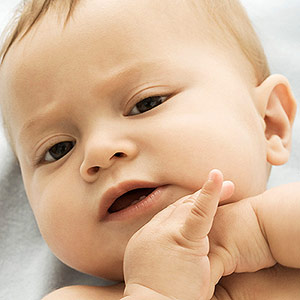|

Growls
Although this throaty noise isn't as common as some other baby sounds, within the first six months many babies do growl -- and it doesn't mean they're unleashing their inner animal. At first, it's just a reflex, like crying or gurgling. But your infant may start making growling sounds (grrr) on purpose because he likes the feeling it produces in his throat, says Diane Paul, Ph.D., director of speech-language pathology for the American Speech-Language-Hearing Association.
As your baby gets older, he may also growl to express displeasure, like when he doesn't want to be smothered in kisses by Aunt Gretchen or he's mad that you're not feeding him fast enough. Growling back will show him that you get it -- and it's fun.
Chuckles
At around 4 months, your little one may surprise you with a small chuckle or even a full-out belly laugh. Initially, chuckles and laughs are a physical response to something you're doing like tickling her knees or blowing air on her tummy. Later on, when your baby laughs at something external -- the look on your face when she flings all of her food onto the floor, for instance -- it means she's starting to develop a sense of humor, and she clearly finds you amusing. Encouraging her newfound funny bone is easy: Just keep doing silly things.
Sighs
Your child will start sighing naturally when he's just a few weeks old because it feels good and eventually because he likes the way you react to it. In fact, sighing may actually serve a useful function: It can be your baby's way of relaxing and letting you know that he is content. So try responding in kind using different lengths and pitches and giving him time to imitate you.
Babbles
Don't be surprised if you hear your baby engaged in a full monologue, in a language of her own. Babies start to babble at around 4 to 6 months, producing a steady stream of different vowel and consonant sounds that seem like they could be words but aren't quite there yet. Your child will start with the easiest sounds, like "p," "b," and "m," according to Diane Paul, Ph.D., director of speech-language pathology for the American Speech-Language-Hearing Association. You'll hear a lot of "puh puh puhs" or "buh buh buhs" at first.
After your baby has had more practice, you'll hear additional variety, and she may produce groups of sounds like "tah tah, ba ba, bee bee." These are the precursor to talking, so "muh muh" may become "mama" and "ba ba" may become "bottle."
There are lots of things you can do to help: When she pauses, babble back. Try new sounds and pitches to see if she'll try to imitate you and make up babble songs. Being responsive will help teach her the patterns of speech and conversation. Back [1] [2]
|

